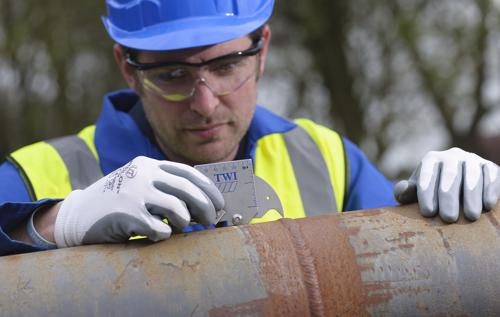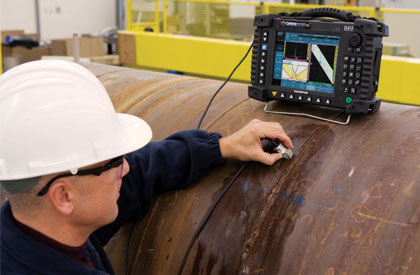The Crucial Duty of Welding Examination: Comprehending the Treatments, Tools, and Criteria That Govern Top Quality Evaluation in Welding Operations
Welding assessment is an essential element of high quality guarantee in welding procedures, making certain the architectural integrity and security of bonded settings up. By using a series of treatments, from pre-weld evaluations to sophisticated non-destructive screening strategies, inspectors systematically assess weld quality against stringent sector criteria. The devices utilized in these processes is important for determining potential defects that could jeopardize performance. Recognizing the interaction between examination techniques and regulative compliance raises vital questions concerning the challenges faced in keeping these necessary protocols. What implications do these factors have on the overall efficacy of welding procedures?
Importance of Welding Assessment
Welding inspection is crucial in making sure the honesty and security of bonded frameworks, as it frequently acts as the final checkpoint before parts are taken into service. The relevance of this evaluation exists in its ability to identify potential defects that might compromise the performance and long life of welded joints. Offered the high stakes entailed, especially in fields such as building and construction, aerospace, and automotive, extensive assessment processes are vital.
Welding problems can emerge from different variables, consisting of inappropriate strategies, poor tools, or inappropriate materials. Failing to detect these problems can result in catastrophic repercussions, including structural failures, which might lead to injury, death, and significant financial obligations. Welding evaluation provides an organized approach to review the top quality of welds, ensuring compliance with market requirements and regulative requirements.
Moreover, efficient welding assessment contributes to improving total efficiency by minimizing rework and making sure that tasks continue to be on timetable. By cultivating a society of quality control, organizations can additionally increase their credibility and client depend on. Essentially, the relevance of welding examination can not be overemphasized, as it plays an essential role in securing both human lives and investments in framework.
Key Examination Procedures
An extensive strategy to assessment treatments is crucial for guaranteeing the quality and dependability of welded joints. Efficient examination begins with pre-weld assessments, that include assessing welding specs, product residential properties, and joint layouts to recognize potential difficulties. This prep work stage develops a baseline for high quality expectations.
During the welding procedure, in-process examinations are crucial. Assessors keep an eye on parameters such as warm input, travel rate, and electrode angle to make certain compliance with well-known criteria. Aesthetic inspections are the first line of protection, making it possible for the identification of surface area issues, such as splits, porosity, or incomplete combination.
Post-weld examinations entail more innovative techniques to analyze the integrity of the joint. This might include non-destructive testing (NDT) methods such as ultrasonic screening, radiographic screening, or magnetic fragment screening. These methods provide much deeper insights right into the interior framework of the weld, revealing prospective problems that might not show up on the surface.
Documents plays an integral function throughout the evaluation process. Detailed records of inspections, including searchings for and rehabilitative activities, ensure traceability and accountability, eventually adding to constant improvement in welding methods and total top quality assurance.
Necessary Devices for Evaluation
Effective assessment counts on making use of customized equipment developed to evaluate the top quality and integrity of bonded joints. Secret tools in this procedure consist of aesthetic evaluation tools, such as multiplying glasses and borescopes, which allow inspectors to determine surface area problems and abnormalities. Additionally, ultrasonic screening (UT) devices plays an important role by making use of high-frequency acoustic waves to identify inner defects within welds, making certain that concealed weaknesses are identified before they result in failure.
Radiographic screening (RT) is another this article essential method, making use of X-rays or gamma rays to create pictures of the welds, exposing inner problems that may not show up via various other inspection approaches - Houston Welding Inspection. Magnetic fragment screening (MT) is utilized for ferromagnetic materials, allowing assessors to discover surface and near-surface problems by using magnetic areas and great bits
Dye penetrant testing (PT) is additionally significant, entailing the application of a fluorescent color to reveal surface splits and suspensions. Each of these tools and techniques adds to an extensive evaluation approach, guaranteeing that bonded structures satisfy the required top quality standards and continue to be safe for use in their respective applications.

Market Standards and Rules
Quality guarantee in welding assessment is substantially influenced by sector requirements and laws that control practices and make certain safety. These requirements work as benchmarks for top quality, outlining the required protocols for screening, examination, and paperwork. Key organizations such as the American Welding Society (AWS), the American Culture of Mechanical Engineers (ASME), and the International Company for Standardization (ISO) develop standards that welding specialists have to abide by throughout the assessment procedure.
Conformity with these standards is not just an issue of governing responsibility yet likewise an essential component of risk monitoring in welding procedures. They encompass different facets, including material selection, welding methods, and credentials of employees. AWS D1.1 lays out architectural welding needs, while ISO 3834 specifies top quality demands for welding processes.
In addition, industry policies dictate the required credentials for welding examiners, necessitating accreditations that affirm their experience. This positioning with criteria makes certain that inspections are done regularly and precisely, eventually guarding the stability of welded frameworks. Sticking to these industry standards and guidelines is vital in promoting functional efficiency and keeping public depend on in welding techniques.
Difficulties in Welding Evaluation


Welding assessment deals with many difficulties that can impact the reliability and security of welded structures. One considerable difficulty is the intricacy of the welding refines themselves, which can vary considerably depending upon products, joint configurations, and environmental problems. This variability demands a thorough understanding of varied inspection techniques my latest blog post and their proper applications.
An additional difficulty depends on the advancing nature of welding innovation. As brand-new materials and techniques are introduced, examiners should continually upgrade their understanding and abilities to efficiently review the high quality of welds. Additionally, the physical ease of access of weld areas can impede examination efforts, particularly in constrained or risky environments.
Furthermore, human variables play a vital duty in welding inspection. Houston Welding Inspection. The subjective nature of visual evaluations can bring about variances, as various examiners may translate the same weld in a different way. This emphasizes the importance of standard click here to find out more training and qualification for inspectors to guarantee an uniform technique to high quality evaluation
Finally, the assimilation of advanced modern technologies, such as automated inspections and artificial intelligence, offers both possibilities and difficulties. While these innovations can enhance precision and effectiveness, they likewise need substantial financial investment and competence to execute properly. Resolving these challenges is essential for preserving the honesty of bonded structures.
Conclusion
Welding assessment is important for making sure the security and integrity of welded frameworks. Eventually, a robust welding assessment structure not just assures conformity with guidelines but also improves general operational performance and dependability. Houston Welding Inspection.
Welding assessment is an important element of top quality assurance in welding procedures, guaranteeing the structural honesty and safety of bonded assemblies.Welding assessment is essential in making sure the honesty and security of bonded frameworks, as it regularly offers as the last checkpoint before parts are put into solution. Welding examination provides an organized strategy to evaluate the quality of welds, making sure compliance with market standards and governing requirements.
Quality guarantee in welding examination is dramatically affected by market standards and guidelines that control techniques and make sure safety. Trick companies such as the American Welding Culture (AWS), the American Culture of Mechanical Engineers (ASME), and the International Company for Standardization (ISO) establish guidelines that welding specialists should adhere to throughout the assessment procedure.